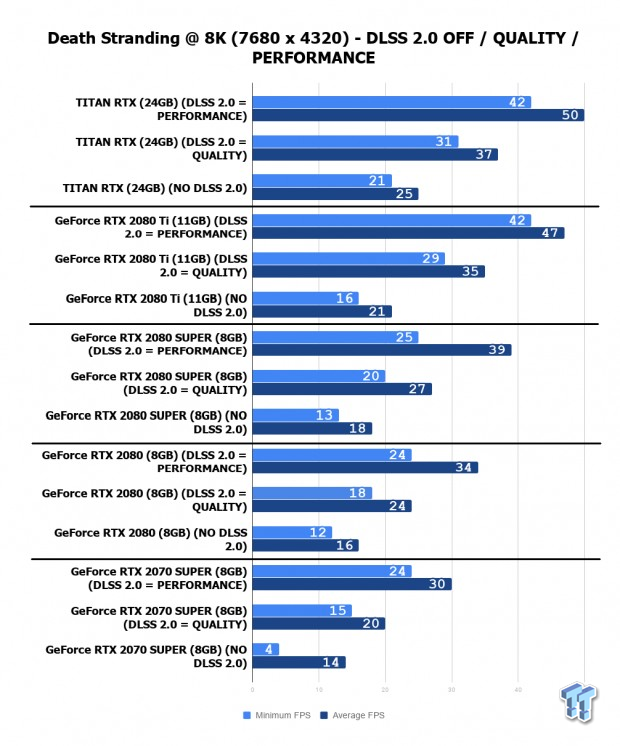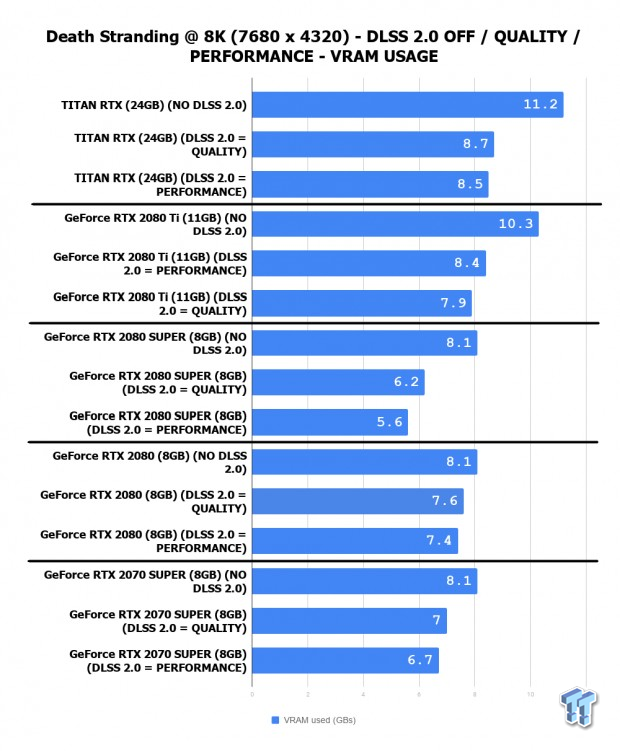Its good to see new stuff come out and I would love to use a 4k resolution with DLSS on top of that. Could look really good in VR. Also great to see Fidelity FX doing such a good job also. Can't wait to see if AMD has something new with Navi 2 and if the consoles will end up with something like it
You are using an out of date browser. It may not display this or other websites correctly.
You should upgrade or use an alternative browser.
You should upgrade or use an alternative browser.
Nvidia DLSS 1 and 2 antialiasing discussion *spawn*
- Thread starter DavidGraham
- Start date
-
- Tags
- nvidia
D
Deleted member 2197
Guest
Removed formatting so should be good to go.@pharma once again please don't copy/paste directly from other websites. The text needs to be cleared of formatting. And the quoted text should be placed in a quote box.
D
Deleted member 2197
Guest
Alexander Battaglia
July 17, 2020
July 17, 2020
Working more on the Checkerboad rendering vs. DLSS 2.0 video today for Death Stranding and I think it is time to write an open letter to about DLSS 2.0 as a quality of life feature on PC that Devs should consider if they use TAA already. Devs please read!
D
Deleted member 2197
Guest
Ampere tensor operations are 2.5x faster than Turing, so the assumption is a similar performance benefit should apply to DLSS usage?
There's also the fixed cost of traversing tensor, irrespective of the actual tensor performance, right?Ampere tensor operations are 2.5x faster than Turing, so the assumption is a similar performance benefit should apply to DLSS usage?
D
Deleted member 2197
Guest
I think the DLSS cost is simply a function of the number of tensor cores available. Alex's tweet makes mention of DLSS 2.0 tensor core usage is likely "maxed out" across the current RTX lineup.
 https://wccftech.com/nvidia-dlss-2-0-behind-the-scenes-how-the-magic-happens/
https://wccftech.com/nvidia-dlss-2-0-behind-the-scenes-how-the-magic-happens/
Ampere increases the number of tensor cores at each GPU tier level, so associated DLSS cost should also decrease. From the graph below it seems the current DLSS 2.0 cost is variable and fairly negligible, and would expect this to shrink further with Ampere's new tensor architecture, efficiency gains.I would assume tensor cores are maxed, hence how it has different performance profile across GPUs with diff TOPs

More crazy experiments, this time upscaling from 270p to 1080p, results are impressive.
I don't have an nvidia card but are you able to select 4k and then have it dlss up to 8k or another resolution higher than 4k ?
DegustatoR
Legend
You select your display resolution and then turn DLSS on with some preset - performance, balanced, quality. If your display is able to show 8K then you can use that with DLSS.I don't have an nvidia card but are you able to select 4k and then have it dlss up to 8k or another resolution higher than 4k ?
If you're thinking of a DSR-type upscaling beyond native, then no not currently.I don't have an nvidia card but are you able to select 4k and then have it dlss up to 8k or another resolution higher than 4k ?
DegustatoR
Legend
You can use DLSS with DSR. If your display is 4K for example and you can setup DSR 4x on it then you will be able to use 8K in a game which works with DSR. If this game supports DLSS then you can turn that on too. As a result the game will render in some lower than 8K res (4K possibly), DLSS will reconstruct that up to 8K and then DSR will downsample back to 4K native of your display.If you're thinking of a DSR-type upscaling beyond native, then no not currently.
More crazy experiments, this time upscaling from 270p to 1080p, results are impressive.
umm... please tell me this only works because temporal subpixel spacing gives more information over time than a single static 270p frame could do?
Otherwise i might have to change my mind about ML upscaling and get rid of some prejudges...
I'd also like to know if this uses specific training data for Control, or if this is a one suits all games solution.
I'm baffled :O
umm... please tell me this only works because temporal subpixel spacing gives more information over time than a single static 270p frame could do?
Otherwise i might have to change my mind about ML upscaling and get rid of some prejudges...
I'd also like to know if this uses specific training data for Control, or if this is a one suits all games solution.
I'm baffled :O
dlss2.0 is generic. It can also be upgraded in isolation without needing changes to game(s). This presentations explains things pretty clearly.
Its. okay. Proper deep learning comes across as sorcery if done rightumm... please tell me this only works because temporal subpixel spacing gives more information over time than a single static 270p frame could do?
Otherwise i might have to change my mind about ML upscaling and get rid of some prejudges...
I'd also like to know if this uses specific training data for Control, or if this is a one suits all games solution.
I'm baffled :O
D
Deleted member 2197
Guest
Some 8K Death Stranding results ...


https://www.tweaktown.com/articles/9532/death-stranding-benchmarked-at-8k-dlss-gpu-cheat-codes/index.html


https://www.tweaktown.com/articles/9532/death-stranding-benchmarked-at-8k-dlss-gpu-cheat-codes/index.html
lol... we're bored and have nothing else to add. 8K here we go.Some 8K Death Stranding results ...


https://www.tweaktown.com/articles/9532/death-stranding-benchmarked-at-8k-dlss-gpu-cheat-codes/index.html
D
Deleted member 2197
Guest
My guess is they will likely do the same once Ampere is released to measure anticipated tensor core and DLSS 3.0 improvements.
Double the performance at 8K is a high benchmark to beat for non ML algorithms.My guess is they will likely do the same once Ampere is released to measure anticipated tensor core and DLSS 3.0 improvements.
gamervivek
Regular
Tweaktown have been doing 8k benchmarks here and there for a while now,
https://www.tweaktown.com/articles/8310/8k-benchmarking-7680-4320-amazing-part/index.html
https://www.tweaktown.com/articles/8310/8k-benchmarking-7680-4320-amazing-part/index.html
Frenetic Pony
Veteran
Honestly, while I'm not "hyped", I pretty curious about the rt performances vs the amd solution, and the dlss evolution with Ampere.
That second part shouldn't be relevant, "Does it run DLSS? - Yes". But raytracing performance should be interesting. Cyberpunk 2077 has more ore less promised to be the premier title for, but I don't know of any current card that can run sun shadows, reflections, ambient occlusion, and emissive testing all at once at a good frame rate. Since they work with Nvidia one wonders at the implication that the Ampere cards, at least top tier, may be able to do that.
Similar threads
- Replies
- 353
- Views
- 28K
- Replies
- 640
- Views
- 77K
- Locked
- Replies
- 10
- Views
- 855
- Replies
- 15
- Views
- 2K
- Replies
- 590
- Views
- 77K
D
